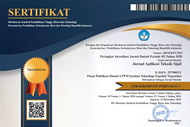Identifikasi Kuantifikasi Risiko Finansial sebagai Dasar Analisis Value for Money pada Proyek Pembangunan Rumah Susun Tambak Wedi Surabaya
Abstract
Keywords
Full Text:
PDFReferences
Kementerian PUPR, “Peraturan Menteri Pekerjaan Umum Dan Perumahan Rakyat Republik Indonesia No. 01/PRT/M/2018,” Jakarta, Indonesia, 2018.
X. Zhai, R. Reed, and A. Mills, “Factors Impeding the Offsite Production of Housing Construction in China: An Investigation of Current Practice,” Construction Management and Economics, vol. 32, no. 1–2, pp. 40–52, 2014, doi: 10.1080/01446193.2013.787491.
F. Rachmawati, C. Susilawati, and A. Goonetilleke, “An Affordability Review for Low-Cost Apartment Rent,” Brisbane, Australia: Proceedings of the 2018 Joint Asia-Pacific Network for Housing Research (APNHR) Conference andthe Australasian Housing Researchers Conference (AHRC), 2018.
F. Rachmawati, R. A. Soemitro, T. J. W. Adi, and C. Susilawati, “Critical Success Factor for Partnership in Low-cost Apartments Project: Indonesia perspective,” Pacific Rim Property Research Journal, vol. 24, no. 2, pp. 149–160, 2018.
R. Khallaf, K. Kang, and M. Hastak, “Analysis of the Use of PPPs in Higher Education Institutions through Systematic Literature Review,” in Construction Research Congress, New Orleans, Louisiana, 2018.
Kementerian Keuangan PUPR, “Mengenal Value for Money dalam Penyediaan Infrastruktur,” Jakarta, Indonesia, 2023. [Online]. Available: https://kpbu.kemenkeu.go.id/read/1092-1254/pjpk/guideline-dan-toolkit/panduan-value-for-money
N. Kavishe, I. Jefferson, and N. Chileshe, “Evaluating Issues and Outcomes Associated with Public–Private Partnership Housing Project Delivery: Tanzanian Practitioners’ Preliminary Observations,” International Journal of Construction Management, vol. 19, no. 4, pp. 354–369, 2019, doi: 10.1080/15623599.2018.1435154.
Z.-Q. F. Hui Sun, Ying Zhou, “Value for Money Test in Infrastructure Procurement,” in International Conference on Logistics Systems and Intelligent Management (ICLSIM), 2010, pp. 549–553.
E. Reeves, “A Review of the PPP Experience in Ireland: Lessons for Comparative Policy Analysis,” Journal of Comparative Policy Analysis: Research and Practice, vol. 17, no. 5, pp. 467–480, 2015, doi: 10.1080/13876988.2015.1023018.
M. H. Pangeran and R. D. Wirahadikusumah, “Challenges in Implementing The Public Sector Comparator for Bid Evaluation of PPP’s Infrastructure Project Investment,” in Proceedings of the First Makassar International Conference on Civil Engineering, 2010, pp. 1229–1239.
M. Siemiatycki and N. Farooqi, “Value for Money and Risk in Public-Private Partnerships,” Journal of the American Planning Association, vol. 78, no. 3, pp. 286–299, 2012, doi: 10.1080/01944363.2012.715525.
M. C. Garrido, M. C. A. Ruotolo, F. M. L. Ribeiro, and H. A. Naked, “Risk Identification Techniques Knowledge and Application in the Brazilian Construction,” Journal of Civil Engineering and Construction Technology, vol. 2, no. 11, pp. 242–252, Nov. 2011, doi: 10.5897/jcect11.024.
C. S. Goh, H. Abdul-Rahman, and Z. Abdul Samad, “Applying Risk Management Workshop for a Public Construction Project: Case Study,” J Constr Eng Manag, vol. 139, no. 5, pp. 572–580, May 2013, doi: 10.1061/(asce)co.1943-7862.0000599.
K. Almarri, S. Alzahrani, and H. Boussabaine, “An Evaluation of the Impact of Risk Cost on Risk Allocation in Public Private Partnership Projects,” Engineering, Construction and Architectural Management, vol. 26, no. 8, pp. 1696–1711, 2019, doi: 10.1108/ECAM-04-2018-0177.
B. Bagenda and Z. Ndevu, “Principal Risks Associated with Public-Private Partnership Projects in Uganda,” Public Works Management and Policy, vol. 0, no. 0, pp. 1–48, 2023, doi: 10.1177/1087724X231167326.
G. Atmo and C. Duffield, “Improving Investment Sustainability for PPP Power Projects in Emerging Economies: Value for Money Framework,” Built Environment Project and Asset Management, vol. 4, no. 4, pp. 335–351, Sep. 2014, doi: 10.1108/BEPAM-10-2013-0051.
PT Penjaminan Infrastruktur Indonesia, “Final Acuan Alokasi Risiko,” Jakarta, Indonesia, 2022.
M. Kassem, M. A. Khoiry, and N. Hamzah, “Using Probability Impact Matrix (PIM) in Analyzing Risk Factors Affecting the Success of Oil and Gas Construction Projects in Yemen,” International Journal of Energy Sector Management, vol. 14, no. 3, pp. 527–546, Mar. 2020, doi: 10.1108/IJESM-03-2019-0011.
DOI: http://dx.doi.org/10.12962%2Fj2579-891X.v22i1.19858
Refbacks
- There are currently no refbacks.

Jurnal Aplikasi Teknik Sipil by Pusat Publikasi Ilmiah LPPM Institut Teknologi Sepuluh Nopember is licensed under a Creative Commons Attribution-ShareAlike 4.0 International License
Based on work at https://iptek.its.ac.id/index.php/jats




